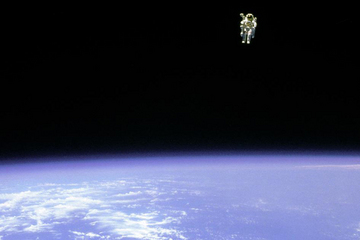
A simple act, such as turning a wrench or using a power drill, can threaten to send free-floating astronauts tumbling out of control in space. But a technology first tested in NASA jetpacks during the Skylab era of the 1970s could help steady astronauts against unwanted rockiness on future spacewalks.
 New simulations have shown how spinning gyroscopes — technology used in the International Space Station and the Hubble Space Telescope — can stabilize astronauts better than jetpacks alone in low-gravity environments. The results may improve the design of NASA's next-generation jetpack for astronauts to wear during planned missions to near-Earth asteroids.
New simulations have shown how spinning gyroscopes — technology used in the International Space Station and the Hubble Space Telescope — can stabilize astronauts better than jetpacks alone in low-gravity environments. The results may improve the design of NASA's next-generation jetpack for astronauts to wear during planned missions to near-Earth asteroids.
"People are going to be doing spacewalks differently in the future without the shuttle and once they're away from the space station," said Jeff Hoffman, a professor of aeronautics and astronautics at MIT.
Hammers in space
Astronauts who conduct spacewalks from the International Space Station (ISS) have the luxury of standing on a robotic arm or using other stabilizing work platforms, but free-floating astronauts working in a low-gravity environment must rely on their jetpacks alone to counteract the forces of their own motions as they hammer or drill away.
Hoffman experienced that sense of instability as a former NASA astronaut who conducted spacewalks to repair a malfunctioning satellite and the Hubble Space Telescope.
"I've done free-floating spacewalk work — you're really unstable," Hoffman told TechNewsDaily. "Every time you exert a force that doesn't go through your center of mass, it tends to not just move you but to also twist you."
Spinning stabilizers
Hoffman and his colleagues at the Draper Laboratory, a nonprofit research and development organization in Cambridge, Mass., see gyroscopes as the answer to steadying space explorers as they shovel, scoop and drill samples from asteroids. The Draper-funded project aims to prove that idea for the benefit of future NASA missions.
"ISS could benefit from this work, but we were inspired to test this concept because ofhumans visiting asteroids," said Bobby Cohanim, a mission design group leader at Draper Laboratory.
The team's computer simulations suggested that a jetpack combined with four gyroscopes would provide greater stability for astronauts than a jetpack by itself. That's because the spinning, electric-powered gyroscopes can turn in a smooth, continuous motion to compensate for any instability, but a jetpack must rely on the "bang bang" action of firing its cold-gas jets in a jerky, start-stop fashion.

 Previous page
Previous page Back to top
Back to top







